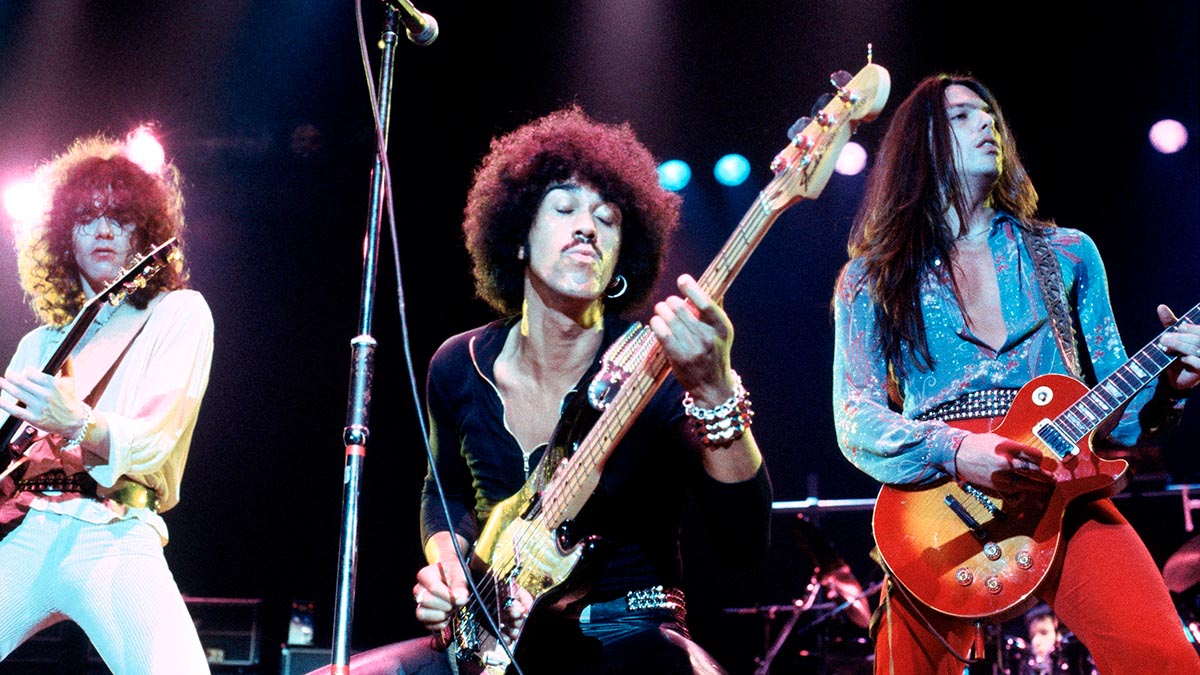Thin Lizzy's Scott Gorham and Brian Robertson brought twin-guitar leads to the masses – master their influential style
Jailbreak your rock chops with a lesson in the playing of two guitarists who influenced every guitar duo that followed

Thin Lizzy are one of the most influential bands of the 1970s, with a line-up that has constantly evolving, to include some of the best rock guitarists in the world.
The band was formed and fronted by bass player and lead vocalist Phil Lynott, along with drummer Brian Downey in Dublin, in 1969. Lynott wrote most of the songs on the band’s 12 albums and was also the first black Irish musician to gain commercial success.
Thin Lizzy didn’t follow many of the other bands of the 1970s in terms of overblown songs and production; instead the writing tended to be concise, dealing with everyday life issues and usually on the shorter side compared to many of their contemporaries. You won’t find too many 15-minute prog rock songs on a Lizzy album!
The band’s breakthrough came in the mid-1970s after a tour supporting Status Quo, and in 1976 The Boys Are Back In Town instantly became one of the best-known and most well-loved rock songs of the past 50 years. Of course, it is also one of the first songs that most people think of when discussing harmony guitar parts.
Scott Gorham and Brian Robertson are perhaps the best-known proponents in the twin-guitar attack of Thin Lizzy, but other notable guitarists who have played in the band are Gary Moore, Snowy White, John Sykes, Midge Ure, and current Def Leppard six-stringer Vivian Campbell, who toured with Thin Lizzy in more recent years.
Thin Lizzy as a band effectively ended with the death of Phil Lynott in 1986, but his legacy lives on with the group still touring with Scott Gorham at the helm, and Ricky Warwick taking on the task of lead vocalist.
Our track is in the key of F# minor (F#-G#-A-B-C#-D-E) and features the kind of harmony parts and blues based pentatonic rock playing that Thin Lizzy helped make popular in the 1970s.
It’s arranged for two guitars throughout, so where one guitar starts with a simple four-bar chord phrase, the other guitar plays a single-note riff that complements it. We also have a good amount of harmony lead playing followed by two solos, one taking over and building from where the other left off. It’s all about playing for the song and listening to your fellow musicians.
The solos are largely F# minor pentatonic-based (F#-A-B-C#-E), with certain phrases adding the remaining notes G# and D from F# natural minor scale. The only non-diatonic note is the b5 (C) in the first solo.
As for as the harmonies themselves, they are built largely on the 3rd above the melody. So, for example, when the first guitar plays F#, the second harmonises with A, and so on. There are a couple of notes that don’t hold strictly to the 3rd harmony, as this makes things sound less predictable and more musical, so make sure you always use your ear as the final judge of what sounds good.
Get the tone
Amp Settings: Gain 6, Bass 6, Middle 7, Treble 6, Reverb 4
This is classic rock territory, so aim for a humbucking sound if possible, or if you have a single-coil guitar simply roll the treble down a tad. It’s a Marshall amp-style sound to aim for, but don’t overdo the front-end gain. Effects with Lizzy were minimal, with perhaps just a touch of reverb or delay, and the occasional use of a wah pedal.
Example 1. Rhythm
There’s no need to play overly aggressively here, as much of the dynamics come from the two different but complementary guitar parts. Aim to play accurately throughout and pay careful attention to fretting notes and chords cleanly, and use damping from both hands to prevent any excess noise.
Example 2. Solo
When playing a harmony line, make sure the phrasing is identical to that of the melody. The solo is largely minor pentatonic, and picking in general will be a blend of down strokes and up strokes, which will probably come instinctively. However, the lead guitar 16th notes are best served by strict alternate picking.
Get The Pick Newsletter
All the latest guitar news, interviews, lessons, reviews, deals and more, direct to your inbox!










![Joe Bonamassa [left] wears a deep blue suit and polka-dotted shirt and plays his green refin Strat; the late Irish blues legend Rory Gallagher [right] screams and inflicts some punishment on his heavily worn number one Stratocaster.](https://cdn.mos.cms.futurecdn.net/cw28h7UBcTVfTLs7p7eiLe.jpg)
